It’s over.
The 2017-18 season is over for the Toronto Maple Leafs after their elimination from the Stanley Cup Playoffs at the hands of the Boston Bruins in Game 7 of their first-round series.
After such a crushing defeat, there is, naturally, much concern and consternation within Leafs Nation.
Does head coach Mike Babcock know what he’s doing? How will the Maple Leafs replace their free-agent forwards? Are their defense and goaltending good enough? If not, should Toronto trade a young star forward for some defensive help?
Everybody calm down. The Maple Leafs are going to be just fine.
The 2017-18 Season That Was
After a surprise qualification for the 2017 postseason – and a very good showing in a first-round loss to the Washington Capitals, much was expected of the Maple Leafs in 2017-18. After all, their rebuild from having been the National Hockey League’s worst team in 2015-16 was, apparently, proceeding much quicker than expected.
Maple Leafs’ Record Regular Season
The Maple Leafs (nearly) lived up to the hype during the regular season, setting franchise records for wins (49) and points (105) in a season – incredible for an organisation over a century old. It was still only good enough to garner them the third playoff slot in the Atlantic Division, but that was more bad luck than anything; the Maple Leafs were the seventh-best team in the NHL, but the Tampa Bay Lightning and the aforementioned Bruins were third and fourth, respectively.
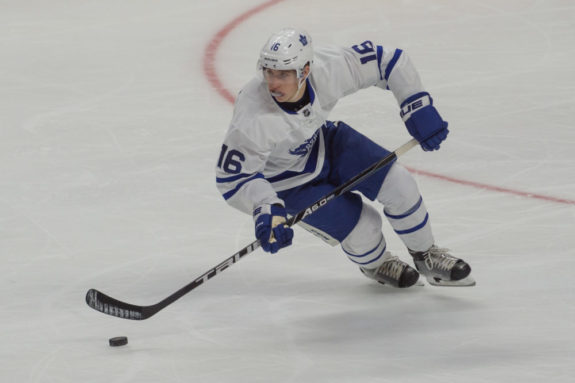
It should also be noted this record-breaking Leafs season was one of some tumult. Toronto started the year trying to outgun everyone like it was the 1980s, to mixed results. They also spent a significant stretch in a mysterious malaise – likely due to a combination of bad luck and a coaching crackdown, unable to do much more than tread water. The Maple Leafs then found their groove, finishing the season on a 23-8-2 run.
The reasons for the inconsistency are anyone’s guess, but it was a memorable year, to be sure.
Maple Leafs Lose in Seven Games to the Bruins…Again
A consequence of the NHL’s unique (though defensible) playoff format is the streaking Maple Leafs had to play the Bruins in the First Round. The Bruins played consistently exceptional hockey all year long and, had they managed more than one win in their final five games, would have claimed top spot in the Atlantic, leaving the Leafs to face the Lightning (which would have been a much better matchup for Toronto).
Unfortunately for the Maple Leafs, despite battling back from a 3-1 series deficit, they succumbed to the Bostonians in Game 7, bringing back memories of their nightmarish loss to the Bruins in 2013.
The reasons for their defeat in Game 7 were many of the same which plagued the Maple Leafs throughout much of the series. A tendency to sit back and parry Boston attacks, rather than taking the game to Boston. A defense corps unable to handle the pressure and workload of containing the relentless Bruins. Some seriously suspect goaltending.
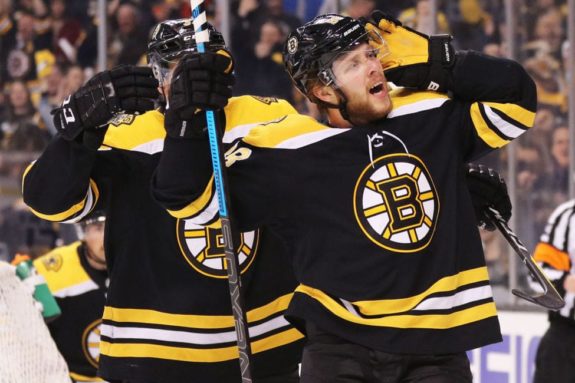
However, let’s pump the brakes on a full rethink here. This isn’t 2013, when a loss to the Bruins exposed the inability of the Maple Leafs to sustainably compete (a condition the organisation proceeded to exponentially worsen). This isn’t some sign of mental weakness, or an indication the Bruins are in the Leafs’ heads; only five players on Toronto’s 2013 roster played for them in this series, and three might well be gone by next year.
In reality, the road to contention is rarely a smooth one, and this is just another bump along the way.
Looking Ahead to the 2018-19 Season
So, with this season in the books, how’s next year shaping up?
Will Maple Leafs Re-Sign or Remake Forward Group?
Three key pieces of the Maple Leafs lineup reach unrestricted free agency this summer, all at the forward position.
James van Riemsdyk, Leo Komarov and Tyler Bozak will all hit the open market, and it would be surprising to see all of them back in a Maple Leafs uniform come the fall.
Van Riemsdyk had a career season in goals, tallying 36 while playing in all but one game. Yes, he only had 18 assists but, let’s be honest, he’s not paid for his playmaking abilities. He’s paid for being a nuisance around the net, and using his quick hands and incredible hand-eye coordination to put the biscuit in the basket.
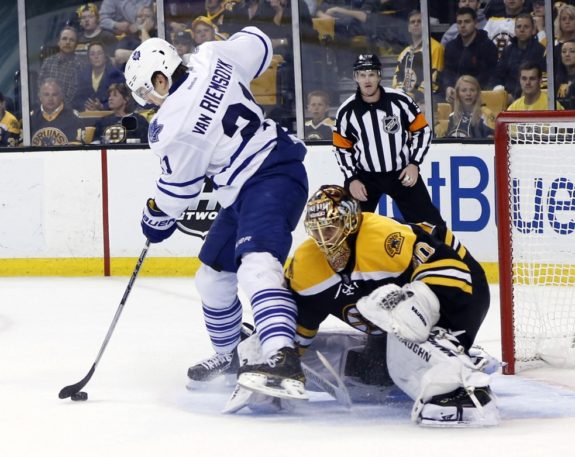
Bozak had another reasonably productive season in what has been a reasonably productive career. His faceoff excellence and power-play prowess, along with his experience playing with top players and in all situations, are going to interest more than a few teams looking to strengthen their centre position.
As for Komarov, Uncle Leo is as beloved a player as the Maple Leafs currently have but, boy, did he ever have an off year. That said, the problems with the pesky, versatile forward were not really his own fault, but rather that of Babcock’s strangely ambitious deployment (putting him on the power play, for example) and a healthy dose of good old-fashioned bad luck (Komarov shot a career-low 6.1 percent, versus a career average of 11.9% coming into the year)
Free-Agent Departures No Death Sentence
The Maple Leafs losing one or more key forwards this offseason shouldn’t set the team back very much.
Yes, some goals will need to be replaced, but the Toronto Marlies and the rest of the Leafs’ farm system have been reliably bringing prospects up to NHL readiness for a couple years now, with players like Andreas Johnsson and Kasperi Kapanen fitting in almost seamlessly with the big club. Thus, the farm system should be able to supply some depth scoring which, if defensively sound, could more than make up for the absence of one or more of the players discussed above.
Additionally, the Maple Leafs could, you know, actually play Josh Leivo.
Such budget-friendly complementary players are not just nice to have; they’ll be essential in ensuring the accommodation of the second contracts of the Maple Leafs’ young stars – the first of whom, William Nylander, needs a new contract this summer – is as painless as possible.
Is Maple Leafs’ Defense Deep Enough?
Probably the most-scrutinised part of the Maple Leafs’ depth chart is their defense corps.
Jake Gardiner (despite a disappointing Game 7), Morgan Rielly and midseason callup Travis Dermott appear to form a pretty reasonable left side, with Rielly having had an exceptional season at both ends of the ice.
The right side is less clear. Ron Hainsey is effective in certain situations, but should not be playing top-pairing minutes, as he looked worn down at times this year. Nikita Zaitsev had a miserable campaign, unable to regain the rhythm that netted him a seven-year contract after only one season in the league. Roman Polak is still Roman Polak, which is to say, probably not the Maple Leafs’ best option.
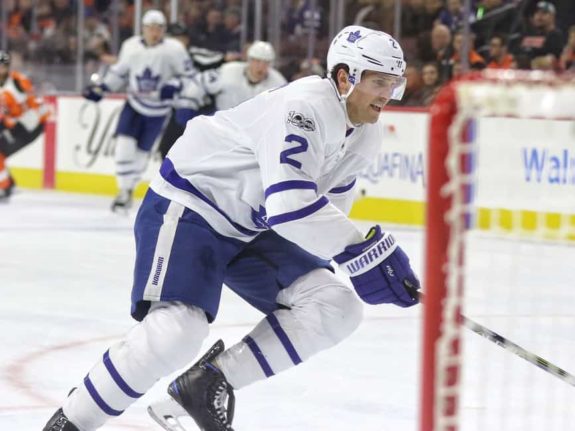
However, help may be at hand if the Leafs are able to get a deal done with Igor Ozhiganov, a defenseman playing in the Kontinental Hockey League. The Maple Leafs are widely perceived as the frontrunners for his services, should he choose to come to North America.
Additionally, several defensemen within the Maple Leafs system played with the big club this season. Dermott, obviously, stuck with the team, but Andreas Borgman, Calle Rosen and Justin Holl also received a look. Highly touted Timothy Liljegren, like Holl, is a right-hand shot – thereby satisfying Babcock’s desire to pair a lefty with a righty – and could get a sniff next season.
What will be interesting is not only whether any of the above players are able to stick with the Maple Leafs next season, but what the team does with Connor Carrick. He’s had his moments of unsteadiness, but can move the puck and, given consistent playing time, is much more effective than Babcock gives him credit for.
Will Competition Improve Maple Leafs’ Goaltending?
Two years into the Frederik Andersen contract, the Maple Leafs would be wise to look for a batterymate for the 28-year-old Dane.
He has posted identical .918 save percentages in his two seasons in Toronto – good, not great, with a .915 in last year’s playoffs and a .896 in the seven games against Boston. Though he did not altogether cost his team the game, Andersen was dreadful in Game 7, and looked decidedly shaky throughout much of the series – even when he won.
Andersen is what he is, interspersing long stretches of brilliance with inexplicable funks and general leakiness.
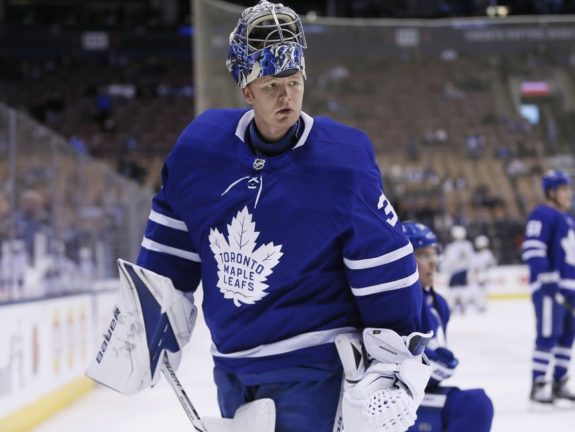
Fortunately, the Maple Leafs have Garret Sparks in their system, a goaltender who has reliably proven he’s far too good for the American Hockey League. This year, Sparks was voted the AHL’s top goaltender, having posted a remarkable 31-9-2 record with an outstanding .936 SV% and six shutouts, and, with partner Calvin Pickard, also took home the award for least goals allowed per game.
Sparks got a taste of the NHL in 2015-16 during the Maple Leafs’ miserable last-place campaign, and has since proven he’s more than ready to be a full-time NHL netminder. A situation in which Andersen plays ~52 games and Sparks ~30 would keep both keepers fresh and ready to step in if the other falters or is injured, while promoting some healthy competition to ensure each is at their respective bests as consistently as possible.
Babcock’s Curious Coaching Decisions
Babcock has truly done an incredible job with the Maple Leafs, taking them from dead-last in the NHL in 2015-16 to 14th last year and then seventh this season. That Toronto’s rebuild is – still – well ahead of schedule is a testament to the talent of Babcock as a coach, just in case his closet full of accomplishments and accolades wasn’t enough to convince you of his prowess.
And that’s not even mentioning how exquisitely he’s developed the likes of Rielly and Nazem Kadri – players who previously lacked a definitive role, turning them into what everyone hoped and dreamed they’d become.
However, that’s not to say there haven’t been any puzzling developments during his Maple Leafs tenure. Quite the contrary, actually.
The aforementioned midseason malaise appeared to be the result of Babcock completely changing the way the Maple Leafs played, to no obvious end. Then there was his worryingly common refusal to ice the Maple Leafs’ best possible lineup. Perhaps most concerningly, after Game 7, Nick Kypreos said Babcock “lost” Auston Matthews.
Look, Babcock is an incredible coach, that much is undisputed. However, there is a growing body of evidence he’s perhaps not as infallible as his reputation would suggest.
Different Look for Maple Leafs Promising
Changes are coming, that’s for sure. However, it’s tough to see how they’d be anything but positive.
The modern NHL is built on speed and starpower. The truly great teams of today – the Nashville Predators and Pittsburgh Penguins come immediately to mind – play a fast, offensively forward game, deploying a core group of star players with affordable accompaniment.
The Maple Leafs already have the horses to play such a style; the stretches they most dominated the Bruins were when they used their blinding speed to outpace the Bostonians all over the ice. Ensuring that each Maple Leafs UFA that departs is replaced by a player who can play, or at least complement, this style, is something both advisable – given the direction the league is heading – and feasible – given the quality of the Leafs’ system.
Moreover, such forthcoming changes will ensure that, when Babcock becomes attached to a certain player or idea, said player or idea is less likely to hurt the Maple Leafs than some of his favourites from this year.
Take a Deep Breath; the Maple Leafs Will Be Fine
A Game 7 loss is always devastating, but things have never looked rosier for this Maple Leafs team.
There might still be pain. Replacing lineup regulars is never an easy task, but doubly so when trying to integrate an NHL newcomer into the fold. It’s unreasonable to expect any player, be they a forward, defenseman or goaltender, to step in and perform optimally right off the bat.
However, the Maple Leafs are well-positioned to surrounded such players with teammates that play a familiar style and who can empathise with being an NHL neophyte.
Simply put, yes, the Maple Leafs have problems, but most of – if not all – the solutions are already in development.
Don’t panic; they’re going to be just fine.